Gwen Stefani, H.E.R., Eric Idle, Audra McDonald and More Stars Toast The Hollywood Bowl’s 100th Anniversary: “There’s No Place Like It”
- Oops!Something went wrong.Please try again later.
- Oops!Something went wrong.Please try again later.

In July 1922, conductor Alfred Hertz led the inaugural concert of the Los Angeles Philharmonic at the Hollywood Bowl. At that time, the stage consisted of a simple wooden platform with a canvas top and guests sitting on moveable wooden benches; the first of its iconic shells wouldn’t be put in place until 1926.
Cut to 100 years later, and the 18,000-seat Bowl (now on its fifth shell) has become an essential part of Los Angeles’ past and present. It’s been the home to iconic concerts from Judy Garland, Frank Sinatra, Jimi Hendrix and The Supremes as well as stage plays, opera, dance and countless performances by the Philharmonic and Hollywood Bowl Orchestra. And it’s just as coveted a place today as ever, as H.E.R., who made her Bowl debut in 2021 alongside the L.A. Phil, recalls: “The way that the Bowl is set up makes it feel so massive, yet so intimate,” she says. “There’s no place like it.” Adds Audra McDonald of her favorite night there, “[At] the celebration of Stephen Sondheim’s 75th birthday in 2005, I stood backstage and watched legend after legend walk onstage: Angela Lansbury, Bernadette Peters, Barbara Cook and so many more. It’s a night I’ll never forget.”
More from The Hollywood Reporter
All the Highlights of the Hollywood Bowl's 100th Anniversary 2022 Season
Kenny Loggins Talks "Danger Zone" Return For 'Top Gun: Maverick' and Upcoming Memoir
The Bowl is a comedy hub too — just recently, it served as the host of several Netflix Is a Joke festival shows (including the one in which Dave Chappelle was attacked onstage by an audience member) — and Monty Python performed four nights there while taping a film in 1982. When the fabled comedy troupe was inducted into the Bowl’s Hall of Fame in 2001, Python’s Eric Idle recalls taking “a curtain call between Stevie Wonder and Smokey Robinson, holding their hands. I’m such a terrific fan, I couldn’t believe it.” Idle also remembers being called several times to open gala performances because “I was very cheap and available and lived close.”
“I’ve played everywhere — I’ve done the Sydney Opera House, I’ve done Carnegie Hall, I’ve done Albert Hall. It’s still the most thrilling place,” Idle says of the Bowl. “I used to do a rant complaining about the travel. I’d go right through the audience and I’d climb over and go through their tables, and it was just such great fun. That was such a great conspiracy — the audience was having such a good time that there was nothing we could do to stop them.”
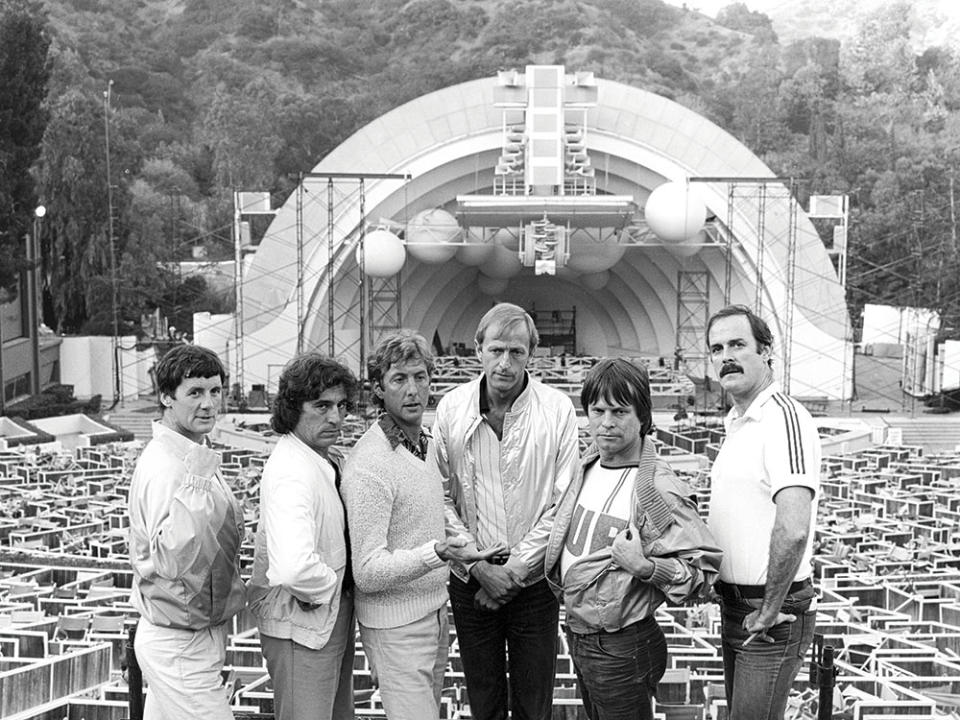
Ben Martin/Getty Images
While the Bowl has welcomed the biggest stars of the past century to its stage, its roots remain in the symphony. After 60 years of heavy lifting by the L.A. Phil, the Hollywood Bowl Orchestra was founded in 1991 to share some show duties and was led by conductor John Mauceri until 2006. He played the works of Hollywood composers at a time when most scores were relegated to studio warehouses after a movie’s release. As a result, Mauceri mainstreamed the Bowl’s now essential live-to-picture performances, with the orchestra playing a film’s score as the movie screens. And in the early days, before digital film, he would have to work off an analog clock to correctly time up the score.
“I would always talk to the audience and say, ‘Listen, what we’re doing here is insane and unnatural, because the picture doesn’t care whether we’re with it or not, it just keeps going,’” remembers Mauceri, noting that the hardest of one of all was the opening for The Sound of Music. “I said, ‘We’re going to be traveling over mountains and see churches and then at some point, you’re gonna see Julie [Andrews] being filmed from a helicopter, she’s gonna twirl and suddenly she’s gonna sing ‘The Hills.’ So for me to get to that exact place, after seven and a half minutes of church bells and tweeting birds,’ I said, ‘is almost impossible.’ And I’d always say, ‘I have a phone here on the stage to call my mother, I have my Tibetan prayer beads.’ And then I would say, ‘And by the way, we’ve tried it twice and I’ve failed, so we’re gonna try it one more time in front of you.’ And I nailed it on that Friday night and the audience just went nuts.” Once digital film came around, Mauceri and his team would go on to develop live-to-picture scoring techniques now used by orchestras around the world.
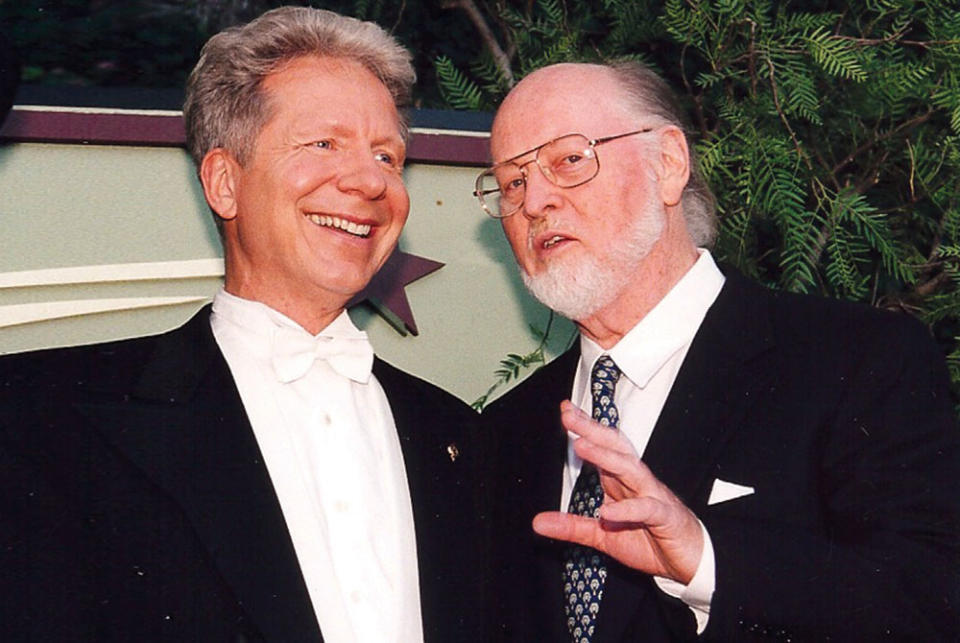
Courtesy Of LA Philharmonic
During his 16 seasons, he also became close to the Hollywood composers whose works he would perform, including John Williams, a longtime Hollywood Bowl staple who still regularly performs his iconic scores there. Mauceri remembers a particularly poignant moment with Ben-Hur composer Miklós Rózsa before his death in 1995.
On the weekend of Rózsa’s 85th birthday, when the composer was in declining health, Mauceri arranged for a giant red phone to be brought on stage, and called Rózsa to play one of his Ben-Hur scores through the phone. “I said, ‘I’m here with 14,000 of your fans to wish you a happy 85th birthday.’ I held the phone out to the audience and they just went nuts.”
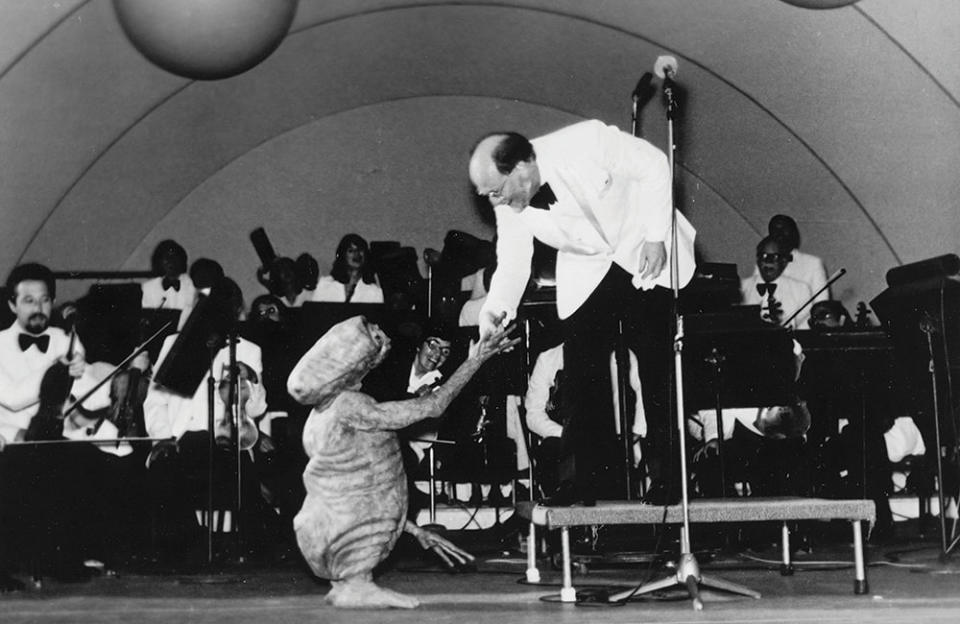
Courtesy Of LA Philharmonic
The orchestra’s current conductor, Thomas Wilkins, has his own significant memories, including leading the world premiere of the Black Panther score (as the first Marvel movie to be shown at the Bowl) in 2021. On rare occasions, Wilkins has also gotten to enjoy the Bowl as an audience member, including Garrison Keillor’s A Prairie Home Companion Show in 2016. “I’m looking around the venue and I’m thinking, ‘Holy cow, this is really awesome!’ I said, ‘I ought to be nervous when I’m working here!’”
Gustavo Dudamel, music and artistic director for the L.A. Phil since 2009, says that though his performances alongside Tony Bennett, Christina Aguilera and Omara Portuondo have been highlights, he looks back on shows from the past two years as among the most meaningful.
“In the most difficult moments of 2020, I remember we were not allowed to play in any place — and the first place where we had the chance to play was here at the Hollywood Bowl,” says Dudamel, noting that the venue closed for the first time in its history amid the pandemic. He conducted a series of filmed concerts there in late 2020 without an audience. “It was magic; it was like a renaissance, to be reborn. Of course, to see the benches empty was sad, but at the same time, we had the opportunity to do music, and we were fighting to get the people back in safe conditions. Now we are having the chance to have everybody here. It has been a challenge, but to see the Bowl full is the best gift we can have.”
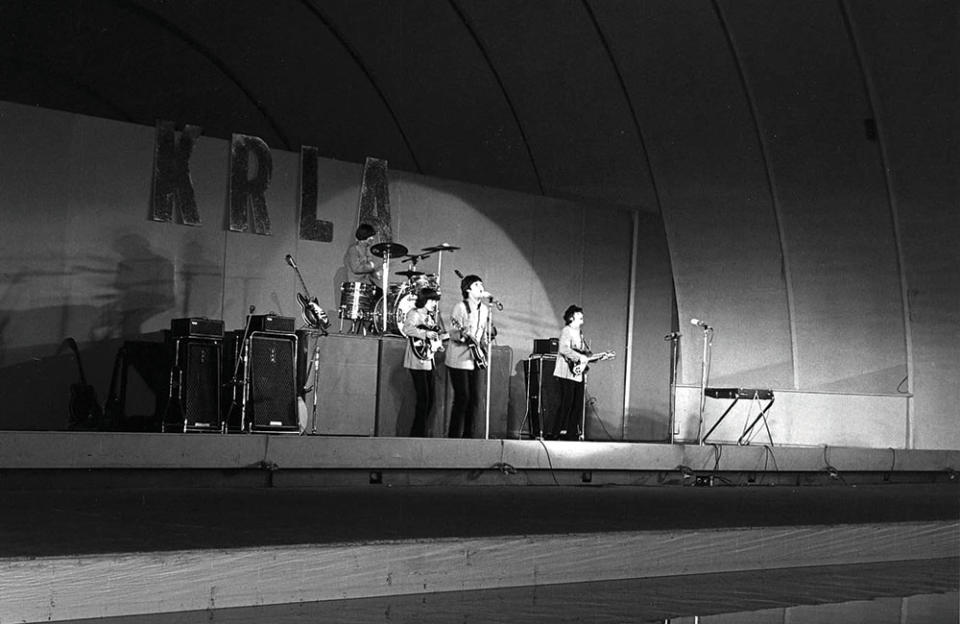
Courtesy Of LA Philharmonic
In 1991, the Bowl teamed up with Andrew Hewitt and Bill Silva Presents as its exclusive concert promotion partners; the two then joined Live Nation in 2018. After bringing in the likes of Bob Dylan, the Beach Boys, Elton John, Jimi Hendrix and B.B. King in the ‘60s and ‘70s, the venue was once again seeking that return to star power — in addition to the orchestra performances — after a slowdown in the ‘80s. Hewitt and Silva were tapped as the solution, leasing out events for major artists outside of the Bowl’s official schedule.
They launched with Paul Simon, after working with neighborhood groups to quell concerns about loud rock bands playing late into the night and a new generation of audiences coming into the venue. The pair also took some feedback from the performers, starting with Simon: “The Philharmonic, still to this day for their events, sets up a pool circle with boxes and they have the famous meal service. The first shows we were doing in ‘91 were set up similarly with that,” remembers Silva. “Paul came out, performed, took a break, came back at the break and told us he hadn’t realized he had signed up to play a supper theater. He was really unhappy about the fact that people were eating their food in front of him instead of rocking out and enjoying the show.”
When Simon recently returned to the Bowl in 2018, Silva reminded him of that moment, which spurred a change in the front pool section from the orchestra boxes to row seating for concert lease events so that nothing separates the crowd from the artist. “He said, ‘I did that?’ says Silva, “and I said, ‘Every artist since thanks you.’”
Hewitt says the early musicians started out as rock and singer-songwriter acts, but have evolved with the culture to embrace electronic, hip-hop and comedy, making the Bowl a must-play for artists hitting L.A. “There’s just no question that the Bowl sells tickets,” adds Silva.
Daniel Song, chief operating officer at the Hollywood Bowl, who started working there as a student volunteer in middle school, says that there have been some key changes to the venue in addition to who plays there, starting with the video screens introduced in 2004.
“What we realized is how it democratizes the Bowl in a way — it gives everyone the best access, whether you’re sitting in the boxes or you’re up there in section Z,” Song says, noting that the higher-up screens are on a slight delay to better line up with the time required for sound to reach those far-away seats. The food has also stepped up in recent years, after pairing with chef Suzanne Goin and restaurateur Caroline Styne, for those who opt to buy rather than bring their own picnic dinners. Longtime box seat owner Cathy Unger, whose family has been frequenting the venue since the ‘30s, says she’s seen attendees do it all when it comes to a night at the Bowl: “People bring wood that they put between the two tables, and then they bring a tablecloth and silverware and crystal. It’s quite amazing what people do.” And the best hack of all for those lucky enough to have season tickets: “It doesn’t get better than valet parking,” says Unger.
The Bowl heads into its 100th season this month, kicking off the summer schedule on June 3 with Gwen Stefani and the LA Phil. Stefani says it’s “an honor to perform at an iconic venue that so many incredible artists have performed. You get to be part of not only your peers, but legendary people that have come long before you. It feels like a one-of-a-kind, iconic moment.”
“People go to the Bowl just to experience this iconic venue, so to be able to be an artist performing there, it’s very special,” she continues. “And I feel very lucky to get to perform with the talented artists of the Los Angeles Philharmonic.”
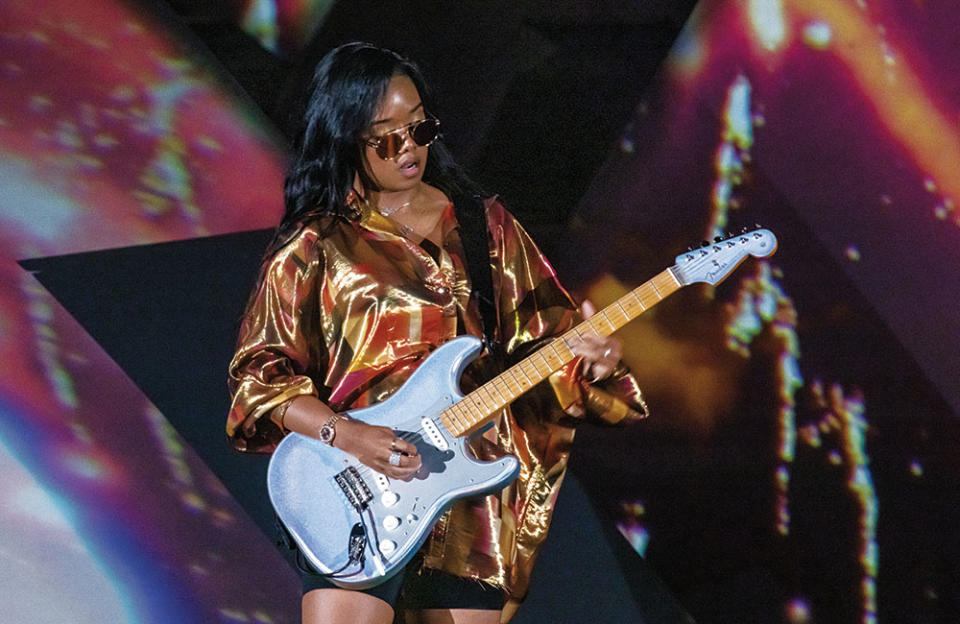
Dustin Downing/Courtesy Of The Los Angeles Philharmonic Association
And as the amphitheater hits its centennial anniversary, Song is also reflecting on what makes the venue so special.
“I talk to so many artists that when they first get onstage at the Bowl and look out, they are just amazed at where they are, who was standing on that stage before them,” he says. “I think we get the benefit of that because when they perform, it’s not just another tour stop. It’s a special place for them.”
Confirms 11-time headliner Rod Stewart, “On a gorgeous summer night in Los Angeles, there is nothing quite like performing at the Hollywood Bowl.”
Evan Nicole Brown contributed to this report.
A version of this story first appeared in the June 1 issue of The Hollywood Reporter magazine. Click here to subscribe.

